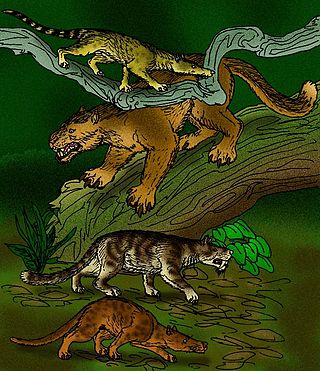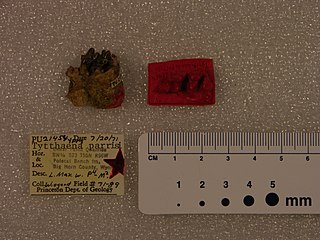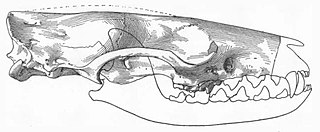Related Research Articles

Creodonta is a former order of extinct carnivorous placental mammals that lived from the early Paleocene to the late Miocene epochs in North America, Europe, Asia and Africa. Originally thought to be a single group of animals ancestral to the modern Carnivora, this order is now usually considered a polyphyletic assemblage of two different groups, the Oxyaenids and the Hyenodonts, not a natural group. Oxyaenids are first known from the Palaeocene of North America, while hyaenodonts hail from the Palaeocene of Africa.

Plesiadapis is one of the oldest known primate-like mammal genera which existed about 58–55 million years ago in North America and Europe. Plesiadapis means "near-Adapis", which is a reference to the adapiform primate of the Eocene period, Adapis. Plesiadapis tricuspidens, the type specimen, is named after the three cusps present on its upper incisors.

Didymictis is an extinct genus of placental mammals from extinct subfamily Didymictinae within extinct family Viverravidae, that lived in North America and Europe from the late Paleocene to middle Eocene.

Tillodontia is an extinct suborder of eutherian mammals known from the Early Paleocene to Late Eocene of China, the Late Paleocene to Middle Eocene of North America where they display their maximum species diversity, the Middle Eocene of Pakistan, and the Early Eocene of Europe. Leaving no descendants, they are most closely related to the pantodonts, another extinct group. The tillodonts were medium- to large-sized animals that probably feed on roots and tubers in temperate to subtropical habitats.
The Clarkforkian North American Stage, on the geologic timescale, is the North American faunal stage according to the North American Land Mammal Ages chronology (NALMA), typically set from 56,800,000 to 55,400,000 years BP lasting 1.4 million years.
The Tiffanian North American Stage on the geologic timescale is the North American faunal stage according to the North American Land Mammal Ages chronology (NALMA), typically set from 60,200,000 to 56,800,000 years BP lasting 3.4 million years.

Eritherium is an extinct genus of early Proboscidea found in the Ouled Abdoun basin, Morocco. It lived about 60 million years ago. It was first named by Emmanuel Gheerbrant in 2009 and the type species is Eritherium azzouzorum. Eritherium is the oldest, smallest and most primitive known elephant relative.

Homogalax is an extinct genus of tapir-like odd-toed ungulate. It was described on the basis of several fossil finds from the northwest of the United States, whereby the majority of the remains come from the state of Wyoming. The finds date to the Lower Eocene between 56 and 48 million years ago. In general, Homogalax was very small, only reaching the weight of today's peccaries, with a maximum of 15 kg. Phylogenetic analysis suggests the genus to be a basal member of the clade that includes today's rhinoceros and tapirs. In contrast to these, Homogalax was adapted to fast locomotion.
The Willwood Formation is a sedimentary sequence deposited during the late Paleocene to early Eocene, or Clarkforkian, Wasatchian and Bridgerian in the NALMA classification.

The Wasatch Formation (Tw) is an extensive highly fossiliferous geologic formation stretching across several basins in Idaho, Montana Wyoming, Utah and western Colorado. It preserves fossils dating back to the Early Eocene period. The formation defines the Wasatchian or Lostcabinian, a period of time used within the NALMA classification, but the formation ranges in age from the Clarkforkian to Bridgerian.

Prolimnocyon is an extinct paraphyletic genus of limnocyonid hyaenodonts that lived in Asia and North America during the late Paleocene to middle Eocene. Prolimnocyon chowi is the earliest known member of the hyaenodontid family Limnocyonidae.

Tytthaena is an extinct genus of placental mammals from extinct subfamily Tytthaeninae within extinct family Oxyaenidae, that lived in North America from the late Paleocene to early Eocene.

Viverravus is an extinct genus of placental mammals from extinct subfamily Viverravinae within extinct family Viverravidae, that lived in North America, Europe and Asia from the middle Paleocene to middle Eocene.

Ignacius is a genus of extinct mammal from the early Cenozoic era. This genus is present in the fossil record from around 62-33 Ma. The earliest known specimens of Ignacius come from the Torrejonian of the Fort Union Formation, Wyoming and the most recent known specimens from Ellesmere Island in northern Canada. Ignacius is one of ten genera within the family Paromomyidae, the longest living family of any plesiadapiforms, persisting for around 30 Ma during the Paleocene and Eocene epochs. The analyses of postcranial fossils by paleontologists suggest that members of the family Paromomyidae, including the genus Ignacius, most likely possessed adaptations for arboreality.
Wyonycteris is a genus of small mammals that existed in the late Paleocene and early Eocene epochs. The type species is Wyonycteris chalix, which lived in Wyoming during the Clarkforkian North American Land Mammal Age of the Paleocene and was originally proposed to be an early form of insectivorous bat. Later re-examination of the material has put this alliance in doubt, and the genus has instead been proposed as belonging to the subfamily Placentidentinae, within the family Nyctitheriidae. Similar fossil material of the same time period found in Europe was later discovered and described as new species, Wyonycteris richardi.
Chiromyoides is a small plesiadapid primatomorph that is known for its unusually robust upper and lower incisors, deep dentary, and comparatively small cheek teeth. Species of Chiromyoides are known from the middle Tiffanian through late Clarkforkian North American Land Mammal Ages (NALMA) of western North America, and from late Paleocene deposits in the Paris Basin, France.
Carpodaptes was a genus that encompassed small, insectivorous animals that roamed the Earth during the Late Paleocene. Specifically, Carpodaptes can be found between the Tiffanian and Clarkforkian periods of North America. Although little evidence, this genus may have made it through to the early Eocene. They are known primarily from collections of jaw and teeth fragments in North America, mainly in southwestern Canada and northwestern America. Carpodaptes are estimated to have weighed approximately 53-96 grams which made them a little bigger than a mouse. However small, Carpodaptes was a placental mammal within the order Plesiadapiformes that appeared to have a high fiber diet. This insect-eating mammal may have been one of the first to evolve fingernails in place of claws. This may have helped them pick insects, nuts, and seeds more easily off the ground than with paws or claws. Carpodaptes was thought to only exist in North America but recent discoveries of dentition fragments have been found in China.
Navajovius is an extinct genus of plesiadapiforms that lived during the Paleocene epoch. Plesiadapiforms were small, arboreal mammals that are theorized to be either closely related to primates or dermopterans. Navajovius has only been documented from localities within North America. This genus was officially named in 1921 by Walter Granger and William Matthew and the type specimen is housed at the American Museum of Natural History.
Saxonella is a genus of extinct primate from the Paleocene Epoch, 66–56 Ma. The genus is present in the fossil record from around ~62–57 Ma. Saxonella has been found in fissure fillings in Walbeck, Germany as well as in the Paskapoo Formation in Alberta, Canada. Saxonella is one of five families within the superfamily Plesiadapoidae, which appears in the fossil record from the mid Paleocene to the early Eocene. Analyses of molars by paleontologists suggest that Saxonella most likely had a folivorous diet.

Periptychus is an extinct genus of mammal belonging to the family Periptychidae. It lived from the Early to Late Paleocene and its fossil remains have been found in North America.
References
- 1 2 3 4 5 6 7 8 9 10 Gingerich, P. D. (1989). New earliest Wasatchian mammalian fauna from the Eocene of northwestern Wyoming: composition and diversity in a rarely sampled high-floodplain assemblage. Museum of Paleontology, University of Michigan.
- 1 2 Rose, K. D., Chew, A. E., Dunn, R. H., Kraus, M. J., Fricke, H. C., & Zack, S. P. (2012). Earliest Eocene mammalian fauna from the Paleocene-Eocene Thermal Maximum at Sand Creek Divide, southern Bighorn Basin, Wyoming. Museum of Paleontology, University of Michigan.
- ↑ Lucas S. G. and R. M. Schoch. 1998. Tillodontia. In C. M. Janis, K. M. Scott, and L. L. Jacobs (eds.), Evolution of Tertiary Mammals of North America 1:268-273.


